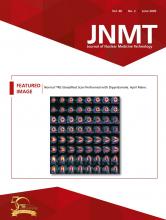Kathy S. Thomas, MHA, CNMT, PET, FSNMMI-TS
It was with great anticipation that I originally sat down to write my editorial for this issue. The June issue of the Journal of Nuclear Medicine Technology (JNMT) was slated to include multiple cardiac discussions that have long been requested by JNMT readers. Final touches were being put on the many plans to celebrate the Technologist Section’s 50th Anniversary in New Orleans, and that celebration would be recorded for future issues of JNMT. The JNMT supplement summarizing the many successes, challenges, and events of the Technologist Section over the last 50 years was coming together through the amazing teamwork of so many dedicated individuals. Then the COVID-19 pandemic savagely struck, and life as we all know it suddenly changed. Countries around the world have been forced to take extraordinary measures in an attempt to slow the spread of the disease. Health-care providers, first responders, and those with essential job positions are stretched to the limit, working with limited resources to provide essential services at great personal risk. New information about the spread of the disease continues to challenge the practice of nuclear medicine. Enhanced safety measures are required for staff to manage patients with known or suspected COVID-19. Protocols must be developed to increase social distancing in a modality that requires direct patient care. How is that being accomplished?
We are fortunate to have 3 excellent discussions in this issue regarding the impact of COVID-19, including 1 by Dr. Gopinath Gnanasegaran et al. (1) on the COVID-19 pandemic and what nuclear medicine professionals should know to help them provide practical solutions for the safety and social well-being of fellow employees as well as the patients they serve. He ends the article with an important message from Celine Dion that we can all take to heart, “Life imposes things on you that you can’t control, but you still have the choice of how you’re going to live through it.”
In these difficult times, continuing education (CE) has become a challenge for nuclear medicine professionals. Many of the spring meetings were cancelled to meet the mandated social-distancing requirements. This issue of JNMT will provide some relief to that crisis, as it includes 4 excellent CE articles. You’ll quickly note that there is a very strong cardiac theme throughout this issue of the JNMT, with 3 of the 4 CE articles discussing cardiac procedures. In the first cardiac CE article, April Mann reviews the considerations for stress testing with myocardial perfusion imaging (2). The second offering, by Mary Beth Farrell (3), defends the importance of quality measurements in nuclear medicine, utilizing the long-standing problem of submaximal exercise stress testing. The final cardiac CE article, also written by Mary Beth Farrell et al. (4), provides an updated procedure standard for gated equilibrium studies. Maria Mackin’s Practical Protocol Tip (5) and Thomas Monreau’s Practical Pointer (6) also support the issue’s cardiac theme by providing specific protocols and tips for gated studies. Additionally, a scientific manuscript written by Ajit Brindhaban (7) adds to the cardiac discussion with the evaluation of the effective dose to patients during SPECT/CT myocardial perfusion imaging. Finally, this June issue launches the first “Student Corner” article, written by Shannon Hammons (8), discussing the basics in myocardial stress tests. We hope to build on student submissions in the future and encourage educators to help us identify student projects worthy of publication. The final CE article discusses the latest on USP 825 and the impact in nuclear medicine—a topic of great interest to every nuclear medicine department (9).
Be sure to explore the other interesting scientific manuscripts and teaching cases included in the June issue. The variety of content is sure to peak the interests of every reader.
Although the future is uncertain at the time of this writing and it is unknown if we will have the opportunity to join together in New Orleans to celebrate the profession as well as the 50th Anniversary of the Technologist Section, I want to personally thank each and every health-care provider, first responder, and those in essential job positions for their dedication and perseverance in these difficult times. As Dr. Johannes Czernin noted in his Editor’s Page in The Journal of Nuclear Medicine, “These are our heroes” (10). Thank you for all you do. Please stay safe and healthy.








